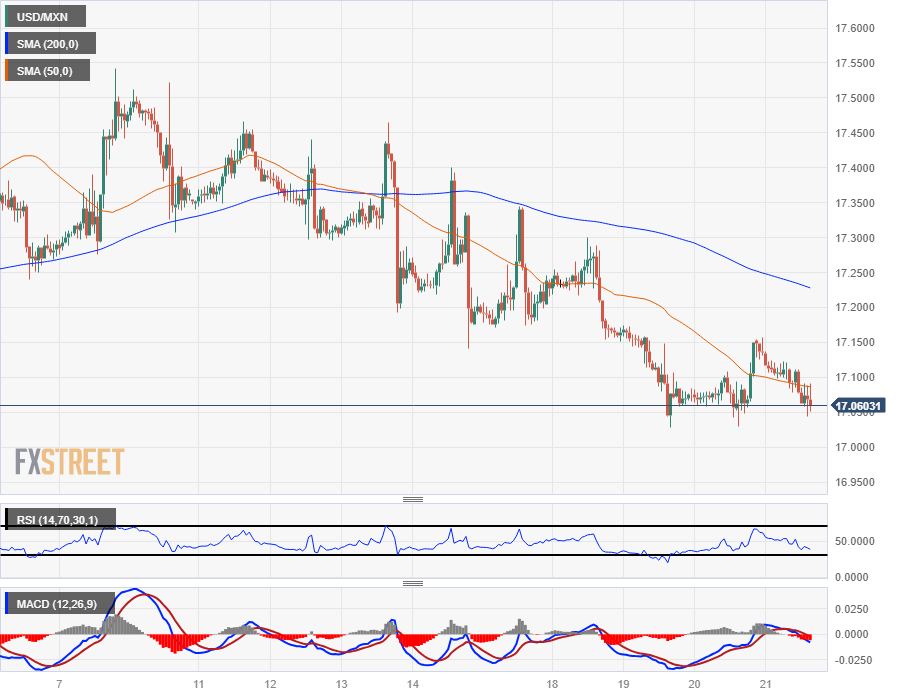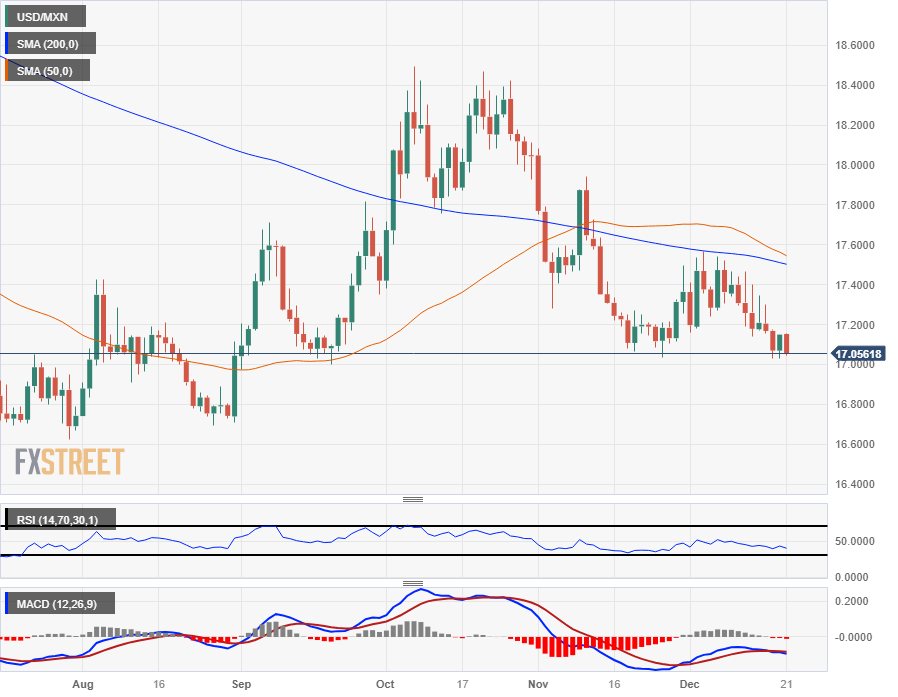Mexican Peso tests new highs as risk appetite rebounds

- Mexican Peso propped up by recovering market sentiment.
- Mexico Trade Balance due Friday to be overshadowed by US PCE Price Index inflation.
- Surprise drop in US inflation indicators pins risk appetite despite overall mixed bag.
The Mexican Peso (MXN) is on the rebound for Thursday, gaining ground against the US Dollar (USD) as broader markets sell off the Greenback despite mixed results from the day’s slew of US data points.
Economic data from Mexico was limited on Thursday, and November’s Mexico Trade Balance figures due on Friday are set to continue being eclipsed by one last print of the US Personal Consumption Expenditures (PCE) Price Index.
Wednesday’s late decline in the Mexican Peso, sparked by a broad-market pullback in equities and other risk assets, has evaporated on Thursday as pre-holiday market churn produces plenty of froth and market moves become harder to explain.
Daily digest market movers: Mexican Peso rebounds to familiar highs in a risk-bid resurgence
- Mexican Peso climbs back into familiar highs against the US Dollar as stock markets rally.
- Broad-market risk appetite rebound sees the MXN up around half a percent against the USD.
- Mexico inflation for the first half-month of December came in above expectations but still declined from the previous period’s 0.63%, printing at 0.52% for the first two weeks of the month versus the forecast decline to 0.4%.
- The Greenback is the single worst-performing currency of the majors on Thursday.
- Easing inflation and growth figures from the US are ramping up market bets of even further rate cuts in 2024.
- US Initial Jobless Claims rose to 205K from 203K (revised upwards slightly from 202K), undercutting the market forecast of 215K.
- Money market rate cut expectations have run far ahead of the Fed’s dot plot; investors see 160 basis points in rate cuts for 2024 versus the Fed’s own expectations of 75 bps.
- US Core PCE inflation settled at 2.0% in the third quarter, below the median market forecast of a hold at 2.3%.
- US Annualized Gross Domestic Product (GDP) also undercut forecasts, printing at 4.9% compared to the expected print of 5.2%.
- Mexico November Trade Balance (in USD terms) is expected to rebound from -252 million to 404 million.
- November’s YoY US Core PCE Price Index inflation, forecast to decline from 3.5% to 3.3%, will be the headliner on Friday and set overall market direction heading into the holiday break.
US Dollar price today
The table below shows the percentage change of US Dollar (USD) against listed major currencies today. US Dollar was the weakest against the Japanese Yen.
| USD | EUR | GBP | CAD | AUD | JPY | NZD | CHF | |
| USD | -0.38% | -0.07% | -0.42% | -0.70% | -0.91% | -0.53% | -0.65% | |
| EUR | 0.38% | 0.30% | -0.07% | -0.36% | -0.53% | -0.16% | -0.30% | |
| GBP | 0.07% | -0.32% | -0.34% | -0.63% | -0.84% | -0.46% | -0.59% | |
| CAD | 0.42% | 0.02% | 0.35% | -0.28% | -0.48% | -0.11% | -0.24% | |
| AUD | 0.73% | 0.33% | 0.66% | 0.30% | -0.16% | 0.20% | 0.06% | |
| JPY | 0.91% | 0.50% | 0.83% | 0.47% | 0.17% | 0.38% | 0.23% | |
| NZD | 0.52% | 0.17% | 0.47% | 0.11% | -0.19% | -0.36% | -0.15% | |
| CHF | 0.65% | 0.29% | 0.60% | 0.22% | -0.07% | -0.25% | 0.12% |
The heat map shows percentage changes of major currencies against each other. The base currency is picked from the left column, while the quote currency is picked from the top row. For example, if you pick the Euro from the left column and move along the horizontal line to the Japanese Yen, the percentage change displayed in the box will represent EUR (base)/JPY (quote).
Technical analysis: Mexican Peso recovers to near-term upper bound
The Mexican Peso (MXN) is pushing back into recent highs against the US Dollar, driving the USD/MXN pair back into the 17.05 neighborhood after etching in a fresh 12-week low of 17.02.
Despite the USD/MXN’s recent downside, meaningful momentum remains limited for the Mexican Peso, and chart activity is set to continue squeezing into consolidation as the 50-day and 200-day Simple Moving Averages (SMA) congest just above the 17.50 level.
It will take a decisive break of support at 16.75 to chalk in a new low for the year and kick off a new uptrend in the Peso for 2024, while any USD/MXN bullish reversals are going to see stiff resistance as a pattern of lower highs sees confluence between the major moving averages and the last swing high.
USD/MXN Hourly Chart
USD/MXN Daily Chart

Inflation FAQs
Inflation measures the rise in the price of a representative basket of goods and services. Headline inflation is usually expressed as a percentage change on a month-on-month (MoM) and year-on-year (YoY) basis. Core inflation excludes more volatile elements such as food and fuel which can fluctuate because of geopolitical and seasonal factors. Core inflation is the figure economists focus on and is the level targeted by central banks, which are mandated to keep inflation at a manageable level, usually around 2%.
The Consumer Price Index (CPI) measures the change in prices of a basket of goods and services over a period of time. It is usually expressed as a percentage change on a month-on-month (MoM) and year-on-year (YoY) basis. Core CPI is the figure targeted by central banks as it excludes volatile food and fuel inputs. When Core CPI rises above 2% it usually results in higher interest rates and vice versa when it falls below 2%. Since higher interest rates are positive for a currency, higher inflation usually results in a stronger currency. The opposite is true when inflation falls.
Although it may seem counter-intuitive, high inflation in a country pushes up the value of its currency and vice versa for lower inflation. This is because the central bank will normally raise interest rates to combat the higher inflation, which attract more global capital inflows from investors looking for a lucrative place to park their money.
Formerly, Gold was the asset investors turned to in times of high inflation because it preserved its value, and whilst investors will often still buy Gold for its safe-haven properties in times of extreme market turmoil, this is not the case most of the time. This is because when inflation is high, central banks will put up interest rates to combat it.
Higher interest rates are negative for Gold because they increase the opportunity-cost of holding Gold vis-a-vis an interest-bearing asset or placing the money in a cash deposit account. On the flipside, lower inflation tends to be positive for Gold as it brings interest rates down, making the bright metal a more viable investment alternative.
